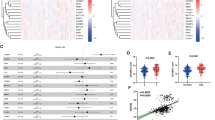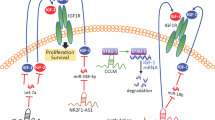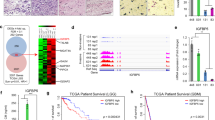Abstract
Signal transduction through the IGF axis is implicated in proliferation, differentiation and survival during development and adult life. The IGF axis includes the IGF binding proteins (IGFBPs) that bind IGFs with high affinity and modulate their activity. In neuroblastoma (NB), a malignant childhood tumor, we found that IGFBP-5 is frequently expressed. Since NB is an IGF2-sensitive tumor, we investigated the relevance and the function of endogenous IGFBP-5 in LAN-5 and in SY5Y(N) cell lines transfected with micro and small interfering RNAs directed to IGFBP-5 mRNA. Cells in which IGFBP-5 expression was suppressed were growth-inhibited and more prone to apoptosis than the parental cell line and controls. Apoptosis was further enhanced by X-ray irradiation. The ability of these cells to undergo neuronal differentiation was impaired after IGFBP-5 inhibition but the effect was reversed by exposure to recombinant IGFBP-5. Together, these data demonstrate the importance of IGFBP-5 for NB cell functions and suggest that IGFBP-5 might serve as a novel therapeutic target in NB.
Similar content being viewed by others
Log in or create a free account to read this content
Gain free access to this article, as well as selected content from this journal and more on nature.com
or
Abbreviations
- DTT:
-
dithiothreitol
- EDTA:
-
ethylene diamine tetra-acetic acid
- ELISA:
-
enzyme-linked immuno-sorbent assay
- RT-PCR:
-
reverse transcriptase-polymerase chain reaction
- SDS:
-
sodium dodecyl sulfate
References
Jones JI and Clemmons DR (1995) Insulin-like growth factors and their binding proteins: biological actions. Endocr. Rev. 16: 3–34
Baserga R, Hongo A, Rubini M, Prisco M and Valentinis B (1997) The IGF-I receptor in cell growth, transformation and apoptosis. Biochim. Biophys. Acta 1332: F105–F126
Allan GJ, Flint DJ and Patel K (2001) Insulin-like growth factor axis during embryonic development. Reproduction 122: 31–39
Isgaard J, Tivesten A, Friberg P and Bengtsson BA (1999) The role of the GH/IGF-I axis for cardiac function and structure. Horm. Metab. Res. 31: 50–54
Anlar B, Sullivan KA and Feldman EL (1999) Insulin-like growth factor-I and central nervous system development. Horm. Metab. Res. 31: 120–125
Liu JP, Baker J, Perkins AS, Robertson EJ and Efstratiadis A (1993) Mice carrying null mutations of the genes encoding insulin-like growth factor I (Igf-1) and type 1 IGF receptor (Igf1r). Cell 75: 59–72
Coolican SA, Samuel DS, Ewton DZ, McWade FJ and Florini JR (1997) The mitogenic and myogenic actions of insulin-like growth factors utilize distinct signaling pathways. J. Biol. Chem. 272: 6653–6662
Clemmons DR (1998) Role of insulin-like growth factor binding proteins in controlling IGF actions. Mol. Cell Endocrinol. 140: 19–24
Booth BA, Boes M, Andress DL, Dake BL, Kiefer MC, Maack C, Linhardt RJ, Bar K, Caldwell EE and Weiler J (1995) IGFBP-3 and IGFBP-5 association with endothelial cells: role of C-terminal heparin binding domain. Growth Regul. 5: 1–17
Parker A, Clarke JB, Busby Jr WH and Clemmons DR (1996) Identification of the extracellular matrix binding sites for insulin-like growth factor-binding protein 5. J. Biol. Chem. 271: 13523–13529
Miyakoshi N, Richman C, Kasukawa Y, Linkhart TA, Baylink DJ and Mohan S (2001) Evidence that IGF-binding protein-5 functions as a growth factor. J. Clin. Invest. 107: 73–81
Duan C and Clemmons DR (1998) Differential expression and biological effects of insulin-like growth factor-binding protein-4 and -5 in vascular smooth muscle cells. J. Biol. Chem. 273: 16836–16842
Kuemmerle JF and Zhou H (2002) Insulin-like growth factor-binding protein-5 (IGFBP-5) stimulates growth and IGF-I secretion in human intestinal smooth muscle by Ras-dependent activation of p38 MAP kinase and Erk1/2 pathways. J. Biol. Chem. 277: 20563–20571
Chan TW, Pollak M and Huynh H (2001) Inhibition of insulin-like growth factor signaling pathways in mammary gland by pure antiestrogen ICI 182,780. Clin. Cancer Res. 7: 2545–2554
Flint DJ, Tonner E and Allan GJ (2000) Insulin-like growth factor binding proteins: IGF-dependent and -independent effects in the mammary gland. J. Mammary Gland Biol. Neoplasia 5: 65–73
Butt AJ, Dickson KA, McDougall F and Baxter RC (2003) Insulin-like growth factor-binding protein-5 inhibits the growth of human breast cancer cells in vitro and in vivo. J. Biol. Chem. 278: 29676–29685
Nickerson T, Pollak M and Huynh H (1998) Castration-induced apoptosis in the rat ventral prostate is associated with increased expression of genes encoding insulin-like growth factor binding proteins 2,3,4 and 5. Endocrinology 139: 807–810
Tonner E, Barber MC, Allan GJ, Beattie J, Webster J, Whitelaw CB and Flint DJ (2002) Insulin-like growth factor binding protein-5 (IGFBP-5) induces premature cell death in the mammary glands of transgenic mice. Development 129: 4547–4557
Beilharz EJ, Klempt ND, Klempt M, Sirimanne E, Dragunow M and Gluckman PD (1993) Differential expression of insulin-like growth factor binding proteins (IGFBP) 4 and 5 mRNA in the rat brain after transient hypoxic-ischemic injury. Brain Res. Mol. Brain Res. 18: 209–215
Perks CM, Bowen S, Gill ZP, Newcomb PV and Holly JM (1999) Differential IGF-independent effects of insulin-like growth factor binding proteins (1-6) on apoptosis of breast epithelial cells. J. Cell Biochem. 75: 652–664
Roschier M, Kuusisto E, Suuronen T, Korhonen P, Kyrylenko S and Salminen A (2001) Insulin-like growth factor binding protein 5 and type-1 insulin-like growth factor receptor are differentially regulated during apoptosis in cerebellar granule cells. J. Neurochem. 76: 11–20
LeRoith D and Roberts Jr CT (2003) The insulin-like growth factor system and cancer. Cancer Lett. 195: 127–137
Baserga R, Peruzzi F and Reiss K (2003) The IGF-1 receptor in cancer biology. Int. J. Cancer 107: 873–877
El Badry OM, Helman LJ, Chatten J, Steinberg SM, Evans AE and Israel MA (1991) Insulin-like growth factor II-mediated proliferation of human neuroblastoma. J. Clin. Invest. 87: 648–657
Brodeur GM (2003) Neuroblastoma: biological insights into a clinical enigma. Nat. Rev. Cancer 3: 203–216
El Badry OM, Romanus JA, Helman LJ, Cooper MJ, Rechler MM and Israel MA (1989) Autonomous growth of a human neuroblastoma cell line is mediated by insulin-like growth factor II. J. Clin. Invest. 84: 829–839
Tanno B, Negroni A, Vitali R, Pirozzoli MC, Cesi V, Mancini C, Calabretta B and Raschella G (2002) Expression of insulin-like growth factor-binding protein 5 in neuroblastoma cells is regulated at the transcriptional level by c-Myb and B-Myb via direct and indirect mechanisms. J. Biol. Chem. 277: 23172–23180
Cesi V, Vitali R, Tanno B, Giuffrida ML, Sesti F, Mancini C and Raschella G. (2004) Insulin-like growth factor binding protein 5 (IGFBP-5): contribution to growth and differentiation of neuroblastoma cells. Ann. NY. Acad. Sci. 1028: 1–10
Zeng Y, Wagner EJ and Cullen BR (2002) Both natural and designed micro RNAs can inhibit the expression of cognate mRNAs when expressed in human cells. Mol. Cell 9: 1327–1333
McManus MT and Sharp PA (2002) Gene silencing in mammals by small interfering RNAs. Nat. Rev. Genet. 3: 737–747
Sui G, Soohoo C, Affar EB, Gay F, Shi Y, Forrester WC and Shi Y (2002) A DNA vector-based RNAi technology to suppress gene expression in mammalian cells. Proc. Natl. Acad. Sci. USA 99: 5515–5520
Kunkel GR, Maser RL, Calvet JP and Pederson T (1986) U6 small nuclear RNA is transcribed by RNA polymerase III. Proc. Natl. Acad. Sci. USA 83: 8575–8579
Paddison PJ, Caudy AA, Bernstein E, Hannon GJ and Conklin DS (2002) Short hairpin RNAs (shRNAs) induce sequence-specific silencing in mammalian cells. Genes Dev. 16: 948–958
Sledz CA, Holko M, de Veer MJ, Silverman RH and Williams BR (2003) Activation of the interferon system by short-interfering RNAs. Nat. Cell Biol. 5: 834–839
Bridge AJ, Pebernard S, Ducraux A, Nicoulaz AL and Iggo R (2003) Induction of an interferon response by RNAi vectors in mammalian cells. Nat. Genet. 34: 263–264
Lovat PE, Di Sano F, Corazzari M, Fazi B, Donnorso RP, Pearson AD, Hall AG, Redfern CP and Piacentini M (2004) Gangliosides link the acidic sphingomyelinase-mediated induction of ceramide to 12-lipoxygenase-dependent apoptosis of neuroblastoma in response to fenretinide. J. Natl. Cancer Inst. 96: 1288–1299
Kouhara H, Koga M, Kasayama S, Tanaka A, Kishimoto T and Sato B (1994) Transforming activity of a newly cloned androgen-induced growth factor. Oncogene 9: 455–462
Ewton DZ, Coolican SA, Mohan S, Chernausek SD and Florini JR (1998) Modulation of insulin-like growth factor actions in L6A1 myoblasts by insulin-like growth factor binding protein (IGFBP)-4 and IGFBP-5: a dual role for IGFBP-5. J. Cell Physiol. 177: 47–57
Byun Y, Chen F, Chang R, Trivedi M, Green KJ and Cryns VL (2001) Caspase cleavage of vimentin disrupts intermediate filaments and promotes apoptosis. Cell Death Differ. 8: 443–450
Gaetano C, Matsumoto K and Thiele CJ (1991) Retinoic acid resistant neuroblastoma cells and the expression of insulin-like growth factor-II. Prog. Clin. Biol. Res. 366: 165–172
Parker A, Rees C, Clarke J, Busby Jr H and Clemmons DR (1998) Binding of insulin-like growth factor (IGF)-binding protein-5 to smooth-muscle cell extracellular matrix is a major determinant of the cellular response to IGF-I. Mol. Biol. Cell 9: 2383–2392
Schwab M and Bishop JM (1988) Sustained expression of the human protooncogene MYCN rescues rat embryo cells from senescence. Proc. Natl. Acad. Sci. USA 85: 9585–9589
Shimizu S, Narita M and Tsujimoto Y (1999) Bcl-2 family proteins regulate the release of apoptogenic cytochrome c by the mitochondrial channel VDAC. Nature 399: 483–487
Lovat PE, Ranalli M, Bernassola F, Tilby M, Malcolm AJ, Pearson AD, Piacentini M, Melino G and Redfern CP (2000) Synergistic induction of apoptosis of neuroblastoma by fenretinide or CD437 in combination with chemotherapeutic drugs. Int. J. Cancer 88: 977–985
Gabbitas B and Canalis E (1997) Retinoic acid regulates the expression of insulin-like growth factors I and II in osteoblasts. J. Cell Physiol. 172: 253–264
Pahlman S, Meyerson G, Lindgren E, Schalling M and Johansson I (1991) Insulin-like growth factor I shifts from promoting cell division to potentiating maturation during neuronal differentiation. Proc. Natl. Acad. Sci. USA 88: 9994–9998
Raschella G, Negroni A, Sala A, Pucci S, Romeo A and Calabretta B (1995) Requirement of b-myb function for survival and differentiative potential of human neuroblastoma cells. J. Biol. Chem. 270: 8540–8545
Raschella G, Tanno B, Bonetto F, Negroni A, Claudio PP, Baldi A, Amendola R, Calabretta B, Giordano A and Paggi MG (1998) The RB-related gene Rb2/p130 in neuroblastoma differentiation and in B-myb promoter down-regulation. Cell Death Differ. 5: 401–407
Acknowledgements
This work was partially supported by the Italian Association for Cancer Research (AIRC), the Foundation against Neuroblastoma (Fondazione NB) and Ricerca Finalizzata Paediatric Hospital Bambino Gesù (OPBG). Vincenzo Cesi is a fellow of the Associazione NB. Roberta Vitali and Maria Laura Giuffrida are recipients of fellowships of the Paediatric Hospital Bambino Gesù (OPBG). BC is supported by grants of the National Institutes of Health.
Author information
Authors and Affiliations
Corresponding author
Additional information
Edited by CJ Thiele
Rights and permissions
About this article
Cite this article
Tanno, B., Cesi, V., Vitali, R. et al. Silencing of endogenous IGFBP-5 by micro RNA interference affects proliferation, apoptosis and differentiation of neuroblastoma cells. Cell Death Differ 12, 213–223 (2005). https://doi.org/10.1038/sj.cdd.4401546
Received:
Revised:
Accepted:
Published:
Issue date:
DOI: https://doi.org/10.1038/sj.cdd.4401546
Keywords
This article is cited by
-
Single-cell analysis of salt-induced hypertensive mouse aortae reveals cellular heterogeneity and state changes
Experimental & Molecular Medicine (2021)
-
IRE1α and IGF signaling predict resistance to an endoplasmic reticulum stress-inducing drug in glioblastoma cells
Scientific Reports (2020)
-
The miR-24-3p/p130Cas: a novel axis regulating the migration and invasion of cancer cells
Scientific Reports (2017)
-
Roles of CDKN1A gene polymorphisms (rs1801270 and rs1059234) in the development of cervical neoplasia
Tumor Biology (2016)
-
IGF binding proteins in cancer: mechanistic and clinical insights
Nature Reviews Cancer (2014)



